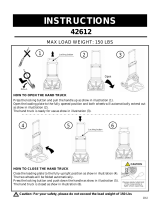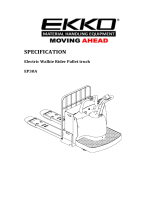
ContChamp DRD-S
Technical Handbook Safety regulations
3
S.Grupp 00
9407
04-10
Continued from previous page
Operating regulations
zBefore starting, make sure that the cab is locked
in the rear-most position by means of the latches,
one on each side. The latches must be secured
with spring pins. (Applies to manually moveable
cabs).
zBefore starting, always check to ensure that no-
body is in the way of the truck or its equipment.
zThe operator must always face the direction of op-
eration and take particular care in areas where
persons or other vehicles are likely to appear in
the vicinity. If visibility is limited by the load, the op-
erator should operate the truck in reverse.
zIt is prohibited to walk or stand underneath raised
forks or other equipment, whether they are loaded
or not.
zIt is prohibited to transport passengers on the
truck outside the cab or on the load. Passengers
may be transported inside the cab only on condi-
tion that it is equipped with a fixed passenger
seat.
zIt is prohibited to lift people if the truck is not
equipped with an approved lift cage.
zIt is prohibited to exceed the load capacity of the
truck. See capacity plate and loading diagram.
zIt is prohibited to transport loads in the raised po-
sition as this entails a risk of the truck tipping. All
transportation shall take place with the load in the
transport position.
zThe operator must adapt the speed of the truck to
the character of the load, conditions of visibility,
the character of the roadway/surface, etc.
zThe operator shall avoid powerful acceleration
and braking when turning. In addition, the opera-
tor shall always moderate the speed of the truck
when turning so as to avoid the risk of lateral skid-
ding or tipping.
zThe operator shall take particular care when oper-
ating in the vicinity of electrical power lines, via-
ducts, quay-sides, ramps, gates/doors etc.
zSafety belts must always be worn, if fitted. In the
event of the truck tipping, always remain in the cab
and grip the steering wheel securely. Never try to
jump out of the cab.
zThe parking brake can also be used as an EMER-
GENCY BRAKE. However, having been used for
emergency braking, the brake linings must be
checked and replaced if necessary. If the parking
brake has been mechanically released, it must
always be reset in order for the truck to regain the
parking brake function.
Interrupted operation, parking
zAlways check that the gear lever is in the neutral
position before turning the ignition key to restart or
to reset an emergency stop.
zNever leave the operator's cab without applying
the parking brake (ON position).
zAlways remove the ignition key if the truck is to be
left unattended.
Other important points to remember
zThe truck's hydraulic system includes high pres-
sure hydraulic accumulators. Always be extremely
careful when working with the hydraulic system
and avoid being unnecessarily close to the hy-
draulic equipment, lines and hoses. Before work-
ing on the hydraulic system, the accumulators
must be emptied into the tank, with the help of the
special accumulator evacuation valve.
zHandle batteries and junction boxes with great
care. The batteries must always be protected over
the poles and connections.
zAlways rectify any damage or wear and tear that
can risk personal safety or that can affect the func-
tions of the truck or its service life.
zAvoid touching oils and greases. Avoid inhaling
exhaust and oil fumes.
zAlways use steps and handrails when entering or
leaving the machine - Never jump!
To avoid the risk of slipping, tread only on anti-slip
surfaces. If the anti-slip protection has become
worn, loose or in any way less effective, it should
be replaced.
zWelding painted steel produces poisonous gas-
ses. Paint should therefore be stripped before
welding, good ventilation ensured and/or face
mask with filter used.
zMobile phones used in the cab must always have
fixed connections to the machine’s electrical sys-
tem, with a fixed antenna outside the machine,
mounted in accordance with the manufacturer’s
instructions. This will avoid interference with the
machine’s important electronic functions.
Operating with attachments
zThe operator must always take the effect of the
wind into account when handling containers.
Avoid lifting with a wind strength in excess of 12
m/s (27 mph/40 feet per second).
zAlways drive carefully so as to avoid attachments
colliding with pillars, cables, etc.
zCarefully study the "Lift methods" section of the
instruction manual.
zThe tensile strength of the top pane can be seri-
ously weakened by exposure to elements that
contain: Aromatic hydrocarbon, ketone, esters or
chlorinated hydrocarbon.
Regularly check the surface condition of the top
pane and clean only with screen wash or other
mild cleaning fluid. After cleaning, rinse thorough-
ly with warm water. It is prohibited to modify or in
any other way make alterations to the top pane.
Immediately replace damaged top panes that
show signs of cracking or scratching.
CE marking
All trucks and equipment (though not thoses fitted on
the truck or intended as spare parts) supplied from Ka-
lmar are CE marked, which indicates that they comply
with the requirements of the EU Machine Safety Direc-
tive. In addition, each truck has a so called, “EU Dec-
laration of Conformity” which is the legal proof that the
truck complies with the “health and safety” require-
ments laid down in the Machine Safety Directive, the
EMC directive (electro-magnetic compatibility) and the
LVD directive (electrical equipment).
Vibration standard
The truck complies with and is below the limits for vi-
bration standard EN 13059.


























